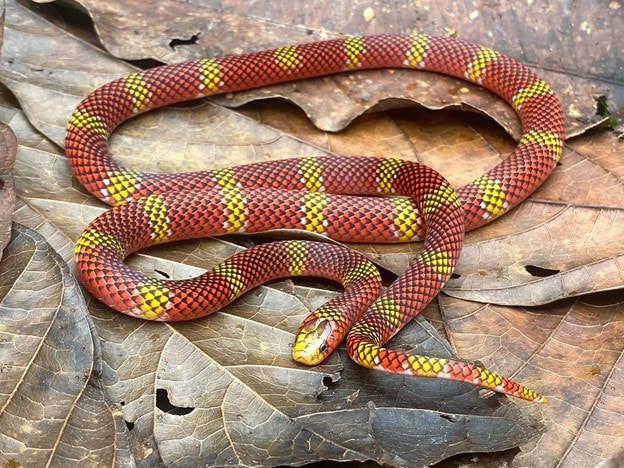|
It’s winter and this finds us writing about amphibians and reptiles rather than surveying them in the field. (Well, that’s not totally true as it’s not winter in the Peruvian Amazon (near Iquitos) where our Venomous Safety Instructor, Matt Cage, is guiding amphibian and reptile enthusiasts and photographers through the jungle.) Here’s a special find he recently shared: Langsdorff’s Coralsnake, Micrurus langsdorffi, photo by Matt Cage Back in North America it is winter, and except for a few warmer spots deep in the southern U.S. our amphibians and reptiles remain hunkered-down a little bit longer before their seasonal activity begins.
However, the deep south (Florida, I’m talking about you) recently did get hit with a cold snap causing iguanas (Spiny-tailed species, Ctenosaura sp., and Green Iguanas, Iguana iguana) to start falling from trees. Iguanas are not native to Florida and thus cold temperatures potentially pose a bigger problem for this species over native ones. Chilly lizards have difficulty escaping predators, and so our native lizards adapt to this lack of heat by overwintering underground and typically below an area subjected to freezing temperatures. Iguanas are not exactly welcome in Florida and cooler temperatures certainly provide opportunities to capture them more easily, potentially helping native wildlife populations by reducing the nonnative competitor of local resources. Iguanas are not cold-tolerant, and this restricts their nonnative populations from expanding. Some nonnative species are more tolerant of cooler temperatures and their populations may expand more easily. For instance, in 2005-6 my collaborators and I studied Cuban Brown Anoles (Anolis sagrei) to evaluate their tolerance to cold in populations from south and central Florida and into Georgia. Individual Cuban Brown Anoles with an ability to tolerate cold were able to find areas to persist. Although this small lizard competes with our native Green Anole (Anolis carolinensis), it’s generally not considered a problem for people. But what happens when a not-so-small lizard figures out a way to survive the cold? This is currently a growing problem in the southeast with Argentine Black-and-White Tegus (Salvator merianae). These lizards compete for burrows in the winter, eat native species (both common and imperiled species), and may negatively impact our own pets and gardens. Control programs are in place, but eradication may be unlikely at this point. Adaptation’s team continues to study wildlife and plant species whether they’re native to certain areas or not. Although species populations naturally shift, our work with agencies better helps our collective understanding of these shifts and species-specific needs. This work helps track non-native species movements to determine how problematic this could be and if control methods are an option. Do you want to help? Maybe you’re not comfortable with identifying wildlife and/ or plants…no worries. Next time you’re outside, notice that cool bug, bird, or flower and share your observation. One way to do this, is through the iNaturalist application. Recording your observations here will get reported to agencies managing our resources for us all.
1 Comment
|
Rattler TattlerAuthorsAdaptation Environmental Team: Bryon, Joe, and Kelly Categories
All
Archives
July 2023
|
|
Copyright © Adaptation Environmental Services L.L.C. circa 2012
|
Denver, Colorado
|


 RSS Feed
RSS Feed